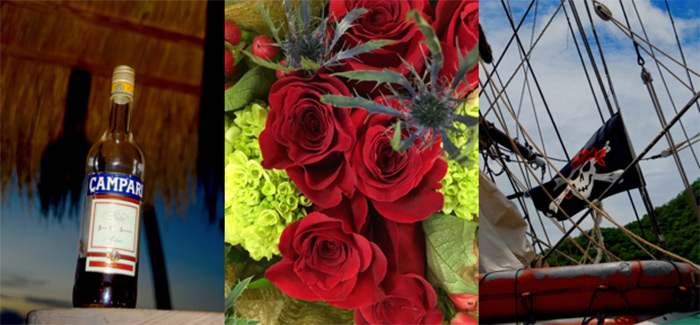If one says ‘red’ – the name of color – and there are fifty people listening, it can be expected that there will be fifty reds in their minds. And one can be sure that all these reds will be very different.
– Josef Albers
If you’re looking for love in all the wrong places this Valentine’s Day, you probably haven’t encountered the perfect red. Not scarlet, burgundy, carnelian, crimson, Falu red, persimmon, sangria, magenta, maroon, Venetian red, vermillion, merlot, mahogany, currant, cherry, garnet, wine, rose, blood, blush, brick, candy, jam, ruby, apple or berry. No, a perfect red the Spanish explorers happened upon in the Aztec marketplaces of 16th century Mexico. For those who knew the secret, the perfect red became a source of power in an age when textiles equated to great wealth. Spain made a fortune selling the rare and precious dye around the globe. In 1587, the conquistadores shipped 65 tons of it home. In a quest to break Spain’s monopoly and acquire the guarded red dyestuff, men turned to espionage and piracy, plundering ships and risking death. All for a fragile little bug that lives on prickly pear cactus.
The female cochineal insect produces carminic acid, a red dye that remains red for centuries. Artists and dyers sought this rich new color to replace other natural pigments such as red ochre and cinnabar that could not rival the intensity or longevity of carmine. Tricky to cultivate and dependent on host cacti native to South America and Mexico, it takes 70,000 insects to produce one pound of dye!
Red, the color of fire and blood, symbolizes passion, desire, seduction, danger, anger, life force and love. Aware that red possesses the power to elicit physical and psychological effects, painters such as Rembrandt, Rubens, van Gogh, van Eyck, Bosch, Tintoretto and Caravaggio embraced carmine pigment to achieve vivid reds.
Directors, cinematographers and costume designers consciously influence audiences with the color red. Think of Scarlet O’Hara’s red dresses, Dorothy’s ruby shoes that carry her home in the Wizard of Oz, Cate Blanchet’s seductive red coats, hats, scarves and lipstick in Carol, the unmistakable symbolism in Yimou’s Raise the Red Lantern, The Red Balloon floating against the grey cement, red clues in the Sixth Sense, a bathtub of red petals in Mendes’ American Beauty, Trois Couleurs: Red by Kieslowski and Spielberg’s haunting image of the little girl in a red coat in Schlinder’s List (only 1 of 4 color images in the film). Often used to signal transition and change, red can depict a dream or fantasy world while reality appears in black and white or monotones. In The Piano, Jane Campion shifts from blue/greens to red/browns from scene to scene to highlight sexual tension.
Since teaching a workshop at the Bowers Museum in conjunction with an exhibition, A Perfect Red, my thoughts now occur in red, my dreams bathed in carmine. I see red on the second hand of clocks, exit signs and fire alarms. I read the Red Wheelbarrow, think of The Scarlet Letter, The Red Badge of Courage, the Rothko play Red. I google famous red heads, red sashed royalty, rosy tattoos and red hats, red light districts, ads for banks and fast food, the AIDS symbol, vintage Vogue covers, red fruits, Steve Job’s holding the red apple and discover red in 77% of all flags. I find out red enhances metabolism, raises blood pressure, increases respiratory rate and stimulates decision making (Buy now, Click here). Red also improves memory…
On travels to Europe and the Caribbean I acquired a lively taste for the Italian aperitif Campari. When I returned to the US, Campari under the same label paled in color and flavor. Unaware of cochineal insects, I would stock up on my next trip. But somewhere along the way I suspected a change in taste while noting a new insipid shade. At about the same time (2009) the FDA decided to ban cochineal food coloring or require serious labeling. Starbucks no longer colors their Strawberries and Crème Frappuccino with carmine and Campari no longer compares. Some suggest pressure from the vegan community heralded the demise of carmine as food coloring or more likely the lower cost of artificial dyes. I don’t know about you, but I would rather take my chances with natural cochineal dye (an extract not bug parts) than ingest carcinogenic artificial red ###.
So if you need a perfect red to enhance your Valentine experience, you could make a quick run to Peru or set sail for the Canary Islands where most cochineal comes from. If that’s not on your compass you can visit the Fullerton Arboretum and handle the juicy insects on the prickly pear cacti. Either way, may you indulge in the persuasive spirit of Valentine’s Day. And never underestimate the power of red!



Today I feel blue – all that red makes my red blood rush to my pale face … may all the valentine cards that hide Ash Wednesday give way to multi colored Easter eggs … and may the colorless rain wash it all away to greet a new day.
Loved this piece . How prescient of me to anticipate as I just bought my first pair of red shoes and I feel daring and liberated from the black, brown and tans. Fantasy, youthful and cheerful come to mind too.
Martha, Your energy is boundless. Your wit exceptional. Your skill with words enchanting. Thanks for the posts. Elaine Barnard
Reluctant to lower the tone of this beautiful blog with a dumb sports reference but soccer teams with red uniforms win more matches than do their cochineal challenged opponents. Go red!
Curious to know how the capture of over one billion bugs a year affected the ecology of their prickly pear cactus hosts.
Martha, As I read your description of the diversity of the colour Red. It occured to me that we have many variables attached to colour. The one that always amazed me is the colour Black. Their are 387 shades of Black., and yet in conversation Black is black. I have just finished reading Doerr's The Light we will not see. If you have not read it, it's a must and beautifully written. Two young lives being lived near Paris and Berlin. She becomes blind at a very young age. I wondered how she saw colour. What would "Red" mean to her. Just a thought
It is interesting how the color red can illicit such strong biological or physiological responses, as well as cognitive. I feel like each person sees color in a slightly different light. We all perceive things within a different frame of meaning. For one, the initial response may be love and passion while for the other it may be violence and anger. Most people have similarly efficient cones in their eyes and a perceptive optic nerve, so it is fascinating to know that what one person experiences with the color may be vastly different to the person next to him or her.